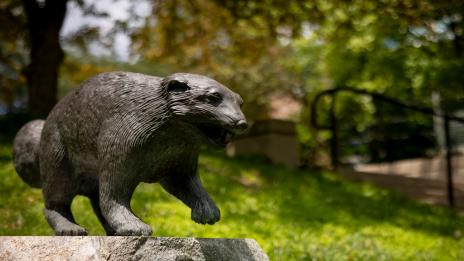By Eric Gallippo | Photos by Center for Academic Innovation & Marc-Grégor Campredon
On a Tuesday afternoon, 15 feet or so below the Maynard Parking Structure, Jeremy Nelson clicked a button and was transported to another planet. A few minutes earlier he’d been on the beach, noting the resolution of the lapping waves; then, standing in a field somewhere in the American South in the early 1800s, before moving to an animated world where an abstract tree helped guide a meditation session. All without leaving Ann Arbor.
After years of developing innovative educational experiences to help faculty reach online and hybrid learners around the world, the University of Michigan Center for Academic Innovation (CAI) recently added a new tool to its toolbox: a next-generation extended-reality (XR) production studio.
Inspired by breakthroughs in virtual production made famous in Disney’s “The Mandalorian” TV series, the center’s XR studio offers U‑M faculty the opportunity to develop cutting-edge online learning experiences and teaching methods using the same software that powers the Sphere auditorium in Las Vegas and blockbuster concerts by Beyoncé and Taylor Swift.
Jeremy Nelson (BSE ’00), the CAI’s senior director of creative studios, said the idea was to bring the center’s experience developing virtual, augmented, and extended-reality educational modules to a broader audience without the need for expensive VR headsets (or the motion sickness that sometimes comes with them).
“‘The Mandalorian’ used this virtual production concept, these big LED screens, to create that episodic show,” Nelson said. “So they weren't going on location, there weren't a lot of post effects, but they were using the same tools we were using to build VR.”
Once initial testing proved that the same concepts and software could be used effectively and efficiently on campus, the center built its own specialized studio—one of six media production studios in the center’s new downtown Ann Arbor headquarters. Moving freely in front of a large installation of 188 LED panels, instructors today can point to notable locations as they change around them; demonstrate detailed techniques in building, visualized meditation, or molecular chemistry; and even “pick up” virtual objects and interact with them.
While the actual filming can be intensive, Nelson said much of the work is done up front, as faculty members work with learning experience designers, media designers, and production staff to identify project goals and the medium and delivery platform to best achieve them. He noted that not every idea is best suited for a Studio X production; in some courses, XR may have a more supplemental role to play, for example.
The center is highly specialized in developing a wide variety of online courses—more than 300 serving nearly 12 million learners in 195 countries to date—as well as evaluating how well they work for users. Those can include anything from for-credit virtual or hybrid offerings to massive open online courses—MOOCs. Many of the latter are free and open to the public—“It's part of our university ethos; educate the world,” Nelson said—and all U‑M-created MOOCs are free to alumni. The center has also developed several online platforms to help improve student performance and experience, including researching classes, building a schedule, working in teams, and preparing for exams.
When it comes to extended reality, Nelson is excited by not just the technical possibilities, but also expanding access to education. One way that’s happening is through overcoming geographical boundaries: By creating models of locations on campus or elsewhere, Studio X can help bring the world to Ann Arbor or Ann Arbor to the world and beyond—the studio recently acquired a model of Mars, complete with interactive rover. So far, subject matter has ranged from architectural practice to Black history in song to life lessons in business.
“They represent a range of disciplines, a range of applications, and a range of techniques that we're using to try and explore as a testbed or a springboard for further applications,” Nelson said.
Before the studio opened, the center had developed a virtual model of the Diag, which it can now use as a background for various videos set on campus. One upcoming project to be shot in the studio involves a Mount Everest climbing simulation as part of a nursing class on health care leadership. Another proposal seeks to recreate a virtual model of the Power Center for the Performing Arts as part of a theater history course that would archive the teaching of a professor who recently retired from the School of Music, Theatre & Dance.
“This project has brought together all these different ideas,” Nelson said. “It’s 3D modeling. It's preserving knowledge of someone who is emeritus now. Could it be open? Could it allow non-SMTD students to take it?”
Production has been tricky, in part due to how and when the Power Center can be accessed—making it an ideal candidate for the team at the Center for Academic Innovation, with the help of Studio X, to help open it up.






